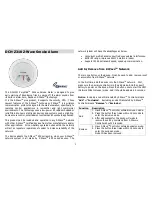
While the system is in the Armed state:
• The Status Indicator Light will be flashing slowly Red to confirm that the
system is armed, and also serve as a visual deterrent.
• The starter interrupt circuit is engaged.
• All protected zones are being monitored for intrusion attempts.
Should an Activation into the Alarm Condition occur:
• The changing-tone electronic siren will loudly sound.
• The parking and interior lights will flash.
• The doors will lock,* regardless of their locked or unlocked status. This feature
is unique- if the system detects that a door is opened, it waits until the door is
closed before relocking it, denying the thief reentry.
An activated alarm condition has a duration of 30 seconds (60 is optional)
unless the system is disarmed using the transmitter, transceiver, or the Valet
Switch. If all protected zones are secure at the end of the alarm condition, the
system will stop and rearm automatically, ready to detect another entry attempt.
If a protected zone is still violated at the end of the alarm condition, the system
will reactivate for up to two additional alarm cycles. After the third alarm cycle
the system will automatically rearm and bypass the open zone until that zone
returns to a normal “non-violated” state.
• Once the system resets after it has been activated, upon disarming the audible
and visual confirmation will change to indicate the activation. This is the
“Activation Alert”, which is explained on pages 11-12.
The Echo Remote Transceiver’s reaction to the alarm condition:
If the remote transceiver was previously used to arm or operate the system, it
will react to an alarm activation, provided it is within range of the system. Upon
receiving a signal from the activated system, the transceiver will:
• The transceiver will start chirping, and continue chirping until any transceiver
button is pressed.
• An icon will start flashing, indicating which protected zone’s violation caused
the system’s alarm condition.
When silencing the transceiver’s alarm chirps, please note the differences of
pressing it’s buttons:
• Pressing “Arm/Lock” will rearm the system, stopping both system’s alarm
condition (leaving it armed) and the transceiver’s chirping.
SYSTEM ARMED & ACTIVATED
* An optional doorlock interface must be installed
Page 9
Page 40
Feature #29 “Tach Wire” or “Tachless” Starter Operation
(Factory Default “Tachless”)
This feature selects the system’s method of detecting the starting and running
of the engine during remote start operation. “Tachless” mode engages the starter
for a predetermined time (previous feature), during which it is monitoring voltage
changes in order to release the starter. While the Tachless method is adequate for
most vehicles, the “Tach Wire” connection is the most reliable form of engine
running information input, and its use is recommended. The Tach Wire option
has a set 3 second starter cranking time, during which it is directly monitoring the
engine’s RPM to release the starter when the engine runs. To use this feature, the
system’s tach input wire must be connected, and a tach learning process followed.
Programming the Tach Wire or Tachless feature:
Prior to programming this feature, please refer to the “Installation Manual”
for proper wiring connection and the Tach Learning Procedure, both of which are
Feature #28
Extended Starter Cranking Time
(Factory Default Setting Minimum)
This feature operates in conjunction with the next feature’s “Tachless”
setting. The Crime Guard 850i
4
’s processor is capable of detecting the running
engine by two separate methods- the use of the vehicle’s tachometer (“tach”) wire
for a direct engine RPM input, or by monitoring the fluctuating voltage levels
caused by the starting process. This feature sets the duration of the starter output’s
base timing for the voltage sensing type of starter output operation. There are four
different base starter output time durations.
Programming Extended Starter Output Time:
Follow Steps 1 to 4 on page 27; at Step 4 the Valet Switch will be pressed and
released twenty eight times. The system’s response will be twenty eight siren
chirps, and the Status Light flashing twenty eight times, pausing, then repeating.
Within 10 seconds, press and release the transmitter/transceiver’s button for one
of these Extended Starter Output Times settings:
"Arm/Lock" button
=
minimum (.7 second) (one siren chirp)
"Disarm/Unlock" button
=
low medium (1.25 seconds) (two siren chirps)
“
II
” button
=
high medium (1.75 seconds) (three siren chirps)
“
III
” button
=
maximum (2.5 seconds) (four siren chirps)
The default-set minimum is sufficient for most vehicles; the Extended Starter
Cranking Time can be used for difficult-to-start engines.
button to configure the system for gasoline engines (the siren will chirp once)
or the "Disarm/Unlock" button to configure the system for diesel engines (the
siren will chirp twice).












































